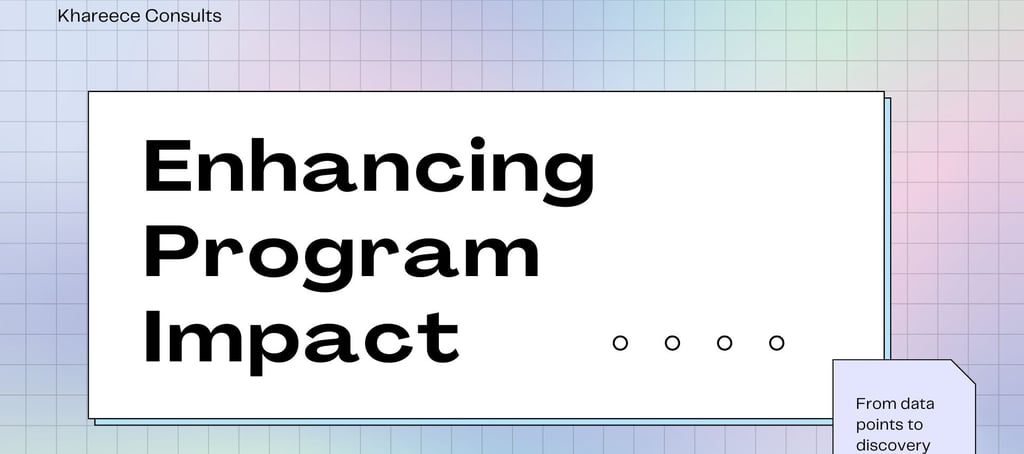Enhancing Program Impact: The Power of Effective Program Evaluation
Organizations are under mounting pressure to demonstrate the efficacy and utility of their initiatives in the modern global landscape. It is imperative to guarantee that your endeavors yield tangible outcomes, regardless of whether you are conducting a nonprofit initiative, corporate social responsibility program, or public health intervention. Program evaluation provides a structured, evidence-based approach to understanding and enhancing the impact of a program.
Isaac Senda PMP
7/22/20244 min read


What is Program Evaluation?
Program evaluation is a systematic process of collecting and analyzing data to assess the design, implementation, and outcomes of a program. Its purpose is to determine whether a program achieves its intended goals, identify areas for improvement, and provide insights that inform decision-making. Effective evaluation isn’t just about measuring success; it’s about continuously refining programs to maximize their impact.
The Key Benefits of Effective Program Evaluation
Informed Decision-Making
Program evaluation provides leaders with reliable data to guide decisions. By understanding what works and what doesn’t, organizations can allocate resources effectively, prioritize impactful initiatives, and make evidence-based adjustments to improve outcomes.
Accountability and Transparency
Stakeholders—including funders, participants, and the public—expect accountability. A well-executed evaluation demonstrates that resources are being used efficiently and that the program delivers measurable results. This transparency builds trust and enhances credibility.
Improved Program Design
Evaluation uncovers insights about program strengths and weaknesses. These findings allow organizations to refine program components, align activities with goals, and address unforeseen challenges, ensuring better performance in the future.
Enhanced Learning and Adaptability
Programs operate in dynamic environments. Regular evaluation fosters a culture of learning, enabling organizations to adapt to changing circumstances, respond to new challenges, and remain effective over time.
Stronger Funding Opportunities
Funders increasingly prioritize evidence of impact when making investment decisions. A robust evaluation framework demonstrates that your organization is results-oriented, improving your chances of securing grants, partnerships, and other funding opportunities.
Types of Program Evaluation
To achieve meaningful insights, it’s essential to use the right type of evaluation at the right time. Common approaches include:
Formative Evaluation: It is conducted during the planning or early stages of a program; formative evaluation assesses the feasibility and potential effectiveness of the program design. They are implemented to assess the quality of the program's design and implementation strategies, make early enhancements or modifications, and guarantee that the program is in accordance with its intended objectives; it helps identify areas for improvement before full-scale implementation. One example of a formative evaluation is community needs assessments that are conducted prior to or during the initial phases of a program or initiative.
Process Evaluation: Focused on program implementation, this type of evaluation examines whether activities are carried out as planned, reaching the intended audience, and meeting expected quality standards. A process evaluation investigates the methods by which a program or initiative accomplishes both the short- and long-term goals. It is concerned with the planned implementation, its ability to reach its intended audiences, and produce the desired outputs. It is always quantitative in nature, emphasizing averages, frequencies, or counts such as number of participants, resources employed to conduct it or time taken to have it complete. Nevertheless, qualitative data may amplify its end goal, such as participant feedback.
Outcome Evaluation: This approach measures the short-term and intermediate effects of a program, such as changes in knowledge, behavior, or attitudes among participants. It is a methodical and unbiased process that entails the collection and analysis of data to ascertain whether the program is accomplishing its intended objectives and goals, as well as whether the results are beneficial and meaningful to the target population.
Impact Evaluation: Going a step further, impact evaluation assesses the long-term effects of a program, determining its ultimate contribution to broader goals or societal change. The observed changes the evaluation finds can be positive and negative, intended and unintended, direct and indirect, and always establishes the cause of the observed changes. For example, a rural program to improve health by reducing waterborne diseases, boosted hygiene practices like handwashing, and increased school attendance, especially for girls, by reducing the time spent fetching water. Furthermore, there was more time for women to engage in income-generating activities. However, unintended negative effects such as congested boreholes leading to conflicts emerged. This highlights an impact evaluation in capturing a comprehensive picture of a program’s effects.
Best Practices for Effective Program Evaluation
1. Set Clear Goals and Objectives: Prior to commencing the assessment, establish the criteria for success. A roadmap for evaluating outcomes and impact is provided by clear, measurable objectives.
2. Involve Stakeholders: Engage critical stakeholders—including beneficiaries, program staff, and funders—in the evaluation process. Their input guarantees that the evaluation addresses pertinent inquiries and fosters consensus regarding the findings and recommendations.
3. Select the Best Methods: Methods that are frequently employed include quantitative, qualitative, or hybrid. In order to obtain a comprehensive understanding of program performance, we recommend the integration of quantitative and qualitative methodologies. Surveys, interviews, focus groups, and data analysis can all yield valuable insights.
4. Integrate evaluation into the program design: Ensure that data collection and analysis are seamlessly incorporated into program operations by incorporating evaluation activities from the outset.
5. Prioritize utilization-focused evaluations: Conduct evaluations that are explicitly directed toward the intended application of the results. This guarantees that the findings are applicable and directly influence program improvement and decision-making.
6. Leverage technology: Data visualization platforms, AI-powered analytics, and real-time interfaces are among the contemporary tools that facilitate the tracking of progress, the analysis of data, and the sharing of insights.
Examples of Program Evaluation in Action
Public Health Initiatives: Evaluating the impact of vaccination campaigns on immunization rates and identifying barriers to uptake.
Education Programs: Assessing the effectiveness of tutoring initiatives in improving student performance.
Environmental Projects: Measuring reductions in carbon emissions resulting from sustainability efforts.
Conclusion
No, effective program evaluation is not an optional addition; it is a critical element of impactful program delivery. Organizations can optimize their influence, adjust to evolving requirements, and demonstrate accountability to stakeholders by adopting evaluation.
In a world where resources are scarce and challenges are numerous, the effectiveness of program evaluation originates from its capacity to guarantee that each endeavor is significant. If you are prepared to increase the impact of your program, begin by incorporating evaluation into the foundation of your strategy—a decision that will yield benefits for years to come.
Ready to strengthen your program’s impact? Let’s collaborate to design an evaluation framework that drives meaningful results.
